Intelligent Geomagnetic Indoor Positioning System
Abstract
:1. Introduction
1.1. Purpose
- We developed a practical algorithm to resist geomagnetic turbulence.
- We designed a geomagnetic indoor positioning system without any infrastructure assistance.
- We integrated Google Maps to display subjects’ current location and trajectory.
- The indoor positioning system can be applied to disaster relief.
1.2. Challenges of Using Geomagnetic Positioning
- (1)
- The geomagnetic triaxial strength measured in different directions at the same position differs.
- (2)
- Occasionally, there is turbulence in the geomagnetic field, and the system must be able to filter out the geomagnetic turbulence.
- (3)
- Building materials, including ferromagnetic materials such as iron, nickel, and cobalt, cause magnetic field data interference.
- (4)
- A geomagnetic variation–displacement relationship model is required to estimate position, and the model needs to be trained to obtain accurate data.
- (5)
- When the system is used in disaster relief, a wireless communication module with high penetration is required.
2. Related Work and Background Knowledge
- (1)
- In an end-to-end localization system using inertial sensors on mobile phones, the sensor module continuously provides the inertial measurement unit (IMU) readings to the estimator and takes the initial position input from the user to provide the current position estimate for the indoor map. A heading estimator incorporates data from sensors. Reliable user heading inference can be an extremely difficult task since the phone’s orientation may change during walking, and the heading inference is still an open problem due to magnetic interference [10]. This system relies on smartphones with inertial sensors (e.g., accelerometers, gyroscopes) to provide indoor positioning. The positioning system needs to integrate step size estimates, along with heading information, to produce displacement. The system needs indoor maps to cooperate with algorithms to provide positioning; the source of constraints is the interior floor plan.
- (2)
- Follow Us, Travi-Navi, and FollowMe [11,12] are indoor positioning systems, peer-to-peer (P2P) navigation systems that follow the leader–follower paradigm. They avoid the extensive setup work and precision requirements of localization. A leader captures the path trajectory, and followers can then navigate the same path. FollowUs can split and join tracks, and generate new tracks from different contributors. FollowUs incrementally provides large-scale indoor navigation without prior knowledge of the floor plan, does not require any infrastructure, and can automatically generate more possible paths. There is also the ability to utilize any available floor plan to speed up the process and build trace/segmented diagrams, further improving navigation efficiency. FollowMe only allows navigation along a route created by one specific leader; Travi-Navi is capable of finding shortcuts and planning trips for users. FollowUs is the only system that constructs graphs based on user traces. Such navigation systems build the historical database first and then integrate the room’s map to support navigation.
- (3)
- There are many reports in the literature about the advantages of magnetic-field positioning with time stability or slow variation and the uniqueness of ferromagnetic interference, which can be used as an indoor localization application [13,14]. In the recent literature on the use of geomagnetic positioning, it was found that the usual practice of geomagnetic positioning includes the following tasks: geomagnetic sensor calibration, the establishment of a geomagnetic database, prediction model establishment [15], and position estimation.
- Geomagnetic sensor calibration: Geomagnetic sensors are inexpensive, low-power sensors that estimate coordinate positions by comparing magnetic field vectors [16,17]. Geomagnetic sensors require calibration for environmental changes [18]. The goal of calibration is to estimate the calibration parameter. Geomagnetic sensor calibration methods use geomagnetic sensing field measurements to estimate unknown calibration parameters [19]. Calibration is considered a parameter optimization problem via maximum likelihood estimation (MLE) and an optimization algorithm [20], derived using gradient and Newton descent methods. The optimal MLE geomagnetic sensor calibration algorithm is based on the quadratic method [21]. Optimal MLE calibration has advantages in accuracy and stability, and the computational cost of optimal MLE calibration is relatively high.
- Establishment of a geomagnetic database: Various indoor buildings generate unique magnetic fields that can be used for indoor localization to identify specific buildings [22]. Magnetic field data show different values for indoor locations and can be used for indoor positioning. The main purpose of establishing geomagnetic data is to use geomagnetic comparison for indoor positioning to confirm the correctness of positioning. There are geomagnetic databases that can be used by researchers. (1) MagPIE is a publicly available dataset for evaluating indoor localization algorithms using magnetic anomalies. The dataset contains geomagnetic sensor measurements and ground truth position measurements with centimeter-level accuracy. This dataset was collected from three different buildings and measured in environments with varying and unchanged object placement affecting the magnetometer [23]. (2) UJI IndoorLoc-Mag is the first geomagnetic dataset for evaluation purposes based on the location of magnetic anomalies. The database was collected in a laboratory of approximately 15 × 20 m [24]. Both of the above require registration. (3) Miskolc IIS Hybrid IPS [25]. This dataset is available without registration (accessed date: 5 May 2023). (4) Magnetic Indoor Positioning System Using Deep Neural Network [17] constructs magnetic landmarks as a magnetic map, and the position of these landmarks is pre-localized during magnetic map construction. The construction and maintenance of a geomagnetic database is a time-consuming and labor-intensive task.
- Prediction model establishment: In a typical Pedestrian Navigation System (PNS) [26], position displacement is determined by aggregating the individual steps. Therefore, the key is to accurately and reliably estimate the step size of each step, which requires the establishment of a length model for estimation [27].
- Position estimation: The indoor positioning method using magnetic fingerprints is a common positioning method, and the location is estimated by comparing the on-site geomagnetic data with the geomagnetic data in the database. The accuracy of geomagnetic positioning depends on the density of fingerprints and high-quality magnetic maps. Fingerprint databases introduce machine learning methods to obtain predictive models. Machine learning methods provide effective data preservation for future use and improve system performance, and can effectively solve many limitations of traditional positioning techniques in indoor environments. Most of the indoor positioning methods studied in the past need to preset positioning facilities or pre-establish map databases before positioning.
3. Materials and Methods
3.1. System Overview
3.2. Geomagnetic Turbulence Filtering
3.3. Unified Azimuth
3.4. GeoMag-Coordinate Model Building and Learning
3.5. Coordinate Estimator
3.6. Position Display
3.7. Super TaiRa Wireless Communication
4. Results
4.1. Geomagnetic Turbulence Filter Test Results
4.2. Coordinate Estimator Test Results
4.3. Comparison with Other Systems
- (1)
- System Availability: The system does not need to preset any positioning facilities to perform indoor positioning, nor does it need to pre-establish any positioning map. System introduction is easy. Especially in disaster relief, as long as it is within the communication range of the command vehicle (LOS 100 km), the commander can monitor the position of the person wearing the sensor.
- (2)
- Critical time limit: Timeliness is the first priority for disaster relief tasks, and the system must be ready. The wireless base station of this system is set up on the command vehicle, and it is very convenient to have communication available as soon as the command vehicle arrives at the scene.
5. Conclusions
- (1)
- Problems solved:
- We developed a practical algorithm that resists the influence of the external environment on geomagnetism and estimates latitude and longitude successfully.
- Based on ubiquitous geomagnetic properties, the indoor position system does not require any infrastructure assistance.
- The indoor positioning accuracy of this system is about 0.8~1.5 m.
- (2)
- Benefits:
- We designed a geomagnetic indoor positioning system without any infrastructure assistance.
- We integrate Google Maps to display subjects’ current location and trajectory.
- The indoor positioning system can be applied to disaster relief.
- The geomagnetic indoor positioning system can be integrated with automatic guided vehicle systems (AGVs) in factories and location-based service (LBS) in shopping malls and underground streets.
Author Contributions
Funding
Data Availability Statement
Acknowledgments
Conflicts of Interest
References
- Basiri, A.; Lohan, E.S.; Moore, T.; Winstanley, A.; Peltola, P.; Hill, C.; Amirian, P.; Silva, P.F. Indoor Location Based Services challenges, requirements and usability of current solutions. Comput. Sci. Rev. 2017, 24, 1–12. [Google Scholar] [CrossRef]
- Kok, M.; Hol, J.D.; Schön, T.B. Indoor Positioning Using Ultrawideband and Inertial Measurements. IEEE Trans. Veh. Technol. 2015, 64, 1293–1303. [Google Scholar] [CrossRef]
- Wang, H.; Gao, K.; Lyu, H. Survey of high-precision localization and the prospect of future evolution. J. Commun. 2021, 42, 198–210. [Google Scholar]
- Oyekanlu, E.A.; Smith, A.C.; Thomas, W.P.; Mulroy, G.; Hitesh, D.; Ramsey, M.; Kuhn, D.J.; Mcghinnis, J.D.; Buonavita, S.C.; Looper, N.A.; et al. A Review of Recent Advances in Automated Guided Vehicle Technologies: Integration Challenges and Research Areas for 5G-Based Smart Manufacturing Applications. IEEE Access 2020, 8, 202312–202353. [Google Scholar] [CrossRef]
- Liu, K.; Liu, X.; Li, X. Guoguo: Enabling fine-grained indoor localization via smartphone. In Proceedings of the MobiSys ‘13: Proceeding of the 11th Annual International Conference on Mobile Systems, Applications, and Services, Taipei, Taiwan, 25–28 June 2013; pp. 235–248. [Google Scholar] [CrossRef]
- Joshi, K.; Hong, S.; Katti, S. PinPoint: Localizing Interfering Radios. NSDI 2013, 10, 2482626–2482651. [Google Scholar]
- Xiong, J.; Jamieson, K. Arraytrack: A fine-grained indoor location system. In Proceedings of the 10th USENIX Symposium on Networked Systems Design and Implementation (NSDI ’13), Lombard, IL, USA, 2–5 April 2013. [Google Scholar]
- Ouyang, G.; Abed-Meraim, K. A Survey of Magnetic-Field-Based Indoor Localization. Electronics 2022, 11, 864. [Google Scholar] [CrossRef]
- Ashraf, I.; Bin Zikria, Y.; Hur, S.; Park, Y. A Comprehensive Analysis of Magnetic Field Based Indoor Positioning With Smartphones: Opportunities, Challenges and Practical Limitations. IEEE Access 2020, 8, 228548–228571. [Google Scholar] [CrossRef]
- Li, F.; Zhao, C.; Ding, G.; Gong, J.; Liu, C.; Zhao, F. A reliable and accurate indoor localization method using phone inertial sensors. In Proceedings of the UbiComp ‘12: Proceedings of the 2012 ACM Conference on Ubiquitous Computing, Pittsburgh, PA, USA, 5–8 September 2012; pp. 421–430. [Google Scholar]
- Shu, Y.; Li, Z.; Karlsson, B.; Lin, Y.; Moscibroda, T.; Shin, K. Incrementally-deployable Indoor Navigation with Automatic Trace Generation. In Proceedings of the IEEE INFOCOM 2019–IEEE Conference on Computer Communications, Paris, France, 29 April–2 May 2019; pp. 2395–2403. [Google Scholar] [CrossRef]
- Shu, Y.; Shin, K.G.; He, T.; Chen, J. Last-Mile Navigation Using Smartphones. In Proceedigns of the MobiCom ‘15: Proceedings of the 21st Annual International Conference on Mobile Computing and Networking, Paris, France, 7–11 September 2015. [Google Scholar] [CrossRef]
- Ashraf, I.; Hur, S.; Park, Y. mPILOT-magnetic field strength based pedestrian indoor localization. Sensors 2018, 18, 2283. [Google Scholar] [CrossRef] [PubMed]
- Zou, Y.; Wang, G.; Wu, K.; Ni, L.M. Smartscanner: Know more in walls with your smartphone! IEEE Trans. Mob. Comput. 2015, 15, 2865–2877. [Google Scholar] [CrossRef]
- Xiao, L.; Behboodi, A.; Mathar, R. A Deep Learning Approach to Fingerprinting Indoor Localization Solutions. In Proceedings of the 2017 27th International Telecommunication Networks and Applications Conference (ITNAC), Melbourne, VIC, Australia, 22–24 November 2017. [Google Scholar]
- Wu, J.; Zhou, Z.; Chen, J.; Fourati, H.; Li, R. Fast complementary filter for attitude estimation using low-cost MARG sensors. IEEE Sens. J. 2016, 16, 6997–7007. [Google Scholar] [CrossRef]
- Lee, N.; Han, D. Magnetic indoor positioning system using deep neural network. In Proceedings of the 2017 International Conference on Indoor Positioning and Indoor Navigation (IPIN), Sapporo, Japan, 18–21 September 2017. [Google Scholar]
- Kok, M.; Schon, T.B. Magnetometer Calibration Using Inertial Sensors. IEEE Sens. J. 2016, 16, 5679–5689. [Google Scholar] [CrossRef]
- Soken, H.E. A survey of calibration algorithms for small satellite magnetometers. Measurement 2018, 122, 417–423. [Google Scholar] [CrossRef]
- Vasconcelos, J.F.; Elkaim, G.; Silvestre, C.; Oliveira, P.; Cardeira, B. Geometric Approach to Strapdown Magnetometer Calibration in Sensor Frame. IEEE Trans. Aerosp. Electron. Syst. 2011, 47, 1293–1306. [Google Scholar] [CrossRef]
- Wu, Y.; Shi, W. On calibration of three-axis magnetometer. IEEE Sens. J. 2015, 15, 6424–6431. [Google Scholar] [CrossRef]
- Ashraf, I.; Hur, S.; Park, Y. BLocate: A Building Identification Scheme in GPS Denied Environments Using Smartphone Sensors. Sensors 2018, 18, 3862. [Google Scholar] [CrossRef] [PubMed]
- Hanley, D.; Faustino, A.B.; Zelman, S.D.; Degenhardt, D.A.; Bret, T. MagPIE: A Dataset for Indoor Positioning with Magnetic Anomalies. In Proceedings of the 2017 International Conference on Indoor Positioning and Indoor Navigation, Sapporo, Japan, 18–21 September 2017. [Google Scholar]
- Torres-Sospedra, J.; Rambla, D.; Montoliu, R.; Belmonte, O.; Huerta, J. UJIIndoorLoc-Mag: A New Database for Magnetic Field-Based Localization Problems. In Proceedings of the International Conference on Indoor Positioning and Indoor Navigation (IPIN), Banff, AB, Canada, 13–16 October 2015; pp. 1–10. [Google Scholar]
- Tóth, Z.; Tamás, J. Miskolc IIS hybrid IPS: Dataset for hybrid indoor positioning. In Proceedings of the 2016 26th International Conference Radioelektronika (RADIOELEKTRONIKA), Kosice, Slovakia, 19–20 April 2016; pp. 408–412. [Google Scholar]
- Wang, Q.; Luo, H.; Wang, J.; Sun, L.; MaRecent, Z.; Fu, M.; Zhang, C.; Zhao, F. Recent Advances in Pedestrian Navigation Activity Recognition: A Review. IEEE Sens. J. 2022, 22, 7499–7518. [Google Scholar] [CrossRef]
- Nessa, A.; Adhikari, B.; Hussain, F.; Fernando, X.N. A Survey of Machine Learning for Indoor Positioning. IEEE Access 2020, 8, 214945–214965. [Google Scholar] [CrossRef]
- Honeywell. 3-Axis Digital Compass IC HMC5883L. Available online: https://cdn-shop.adafruit.com/datasheets/HMC5883L_3-Axis_Digital_Compass_IC.pdf (accessed on 1 April 2023).
- Xu, X.; Lin, L. Geomagnetic Fingerprint Maps for Indoor Positioning. In Proceedings of the 2017 International Conference on Cyber-Enabled Distributed Computing and Knowledge Discovery, Nanjing, China, 12–14 October 2017. [Google Scholar]
- Cao, W. Geomagnetic Signal Detecting based on Magnetoresistive Sensor. Master’s Thesis, Huazhong University of Science & Technology, Wuhan, China, 2007. [Google Scholar]
- Bowen, K. Arduino Interactive Design; Acer Peak Information Co., Ltd.: Hong Kong, 2014; ISBN 9789863471004. [Google Scholar]
- Waheed, A. Analysis of Moving Average Convergence Divergence (MACD) as a Tool of Equity Trading at the Karachi Stock Exchange. Master’s Thesis, Blekinge Tekniska Högskola, Karlskrona, Sweden, 2013. [Google Scholar]
- C# Corner. Available online: https://www.c-sharpcorner.com/blogs/integrate-google-map-in-c-sharp (accessed on 1 April 2023).
- Asmag. Safety Monitoring and Alarm System for Firefighters. Available online: https://www.asmag.com.tw/suppliers/productcontent.aspx?co=k-best&id=1788 (accessed on 1 April 2023).
- Nguyen, K.A.; Luo, Z. Dynamic route prediction with the magnetic field strength for indoor positioning. Int. J. Wirel. Mob. Comput. 2017, 12, 16. [Google Scholar] [CrossRef]
- Li, P.; Yang, X.; Yin, Y.; Gao, S.; Niu, Q. Smartphone-Based Indoor Localization with Integrated Fingerprint Signal. IEEE Access 2020, 8, 33178–33187. [Google Scholar] [CrossRef]
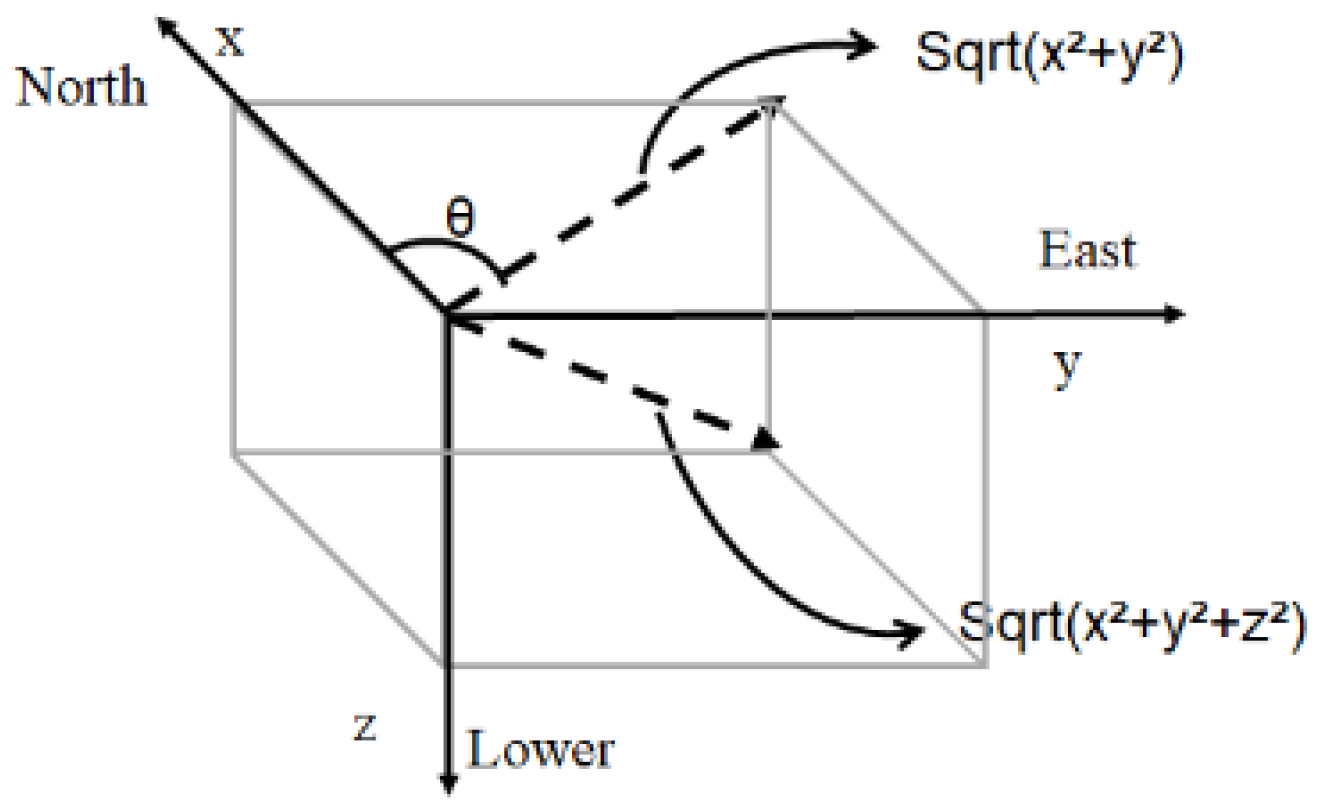

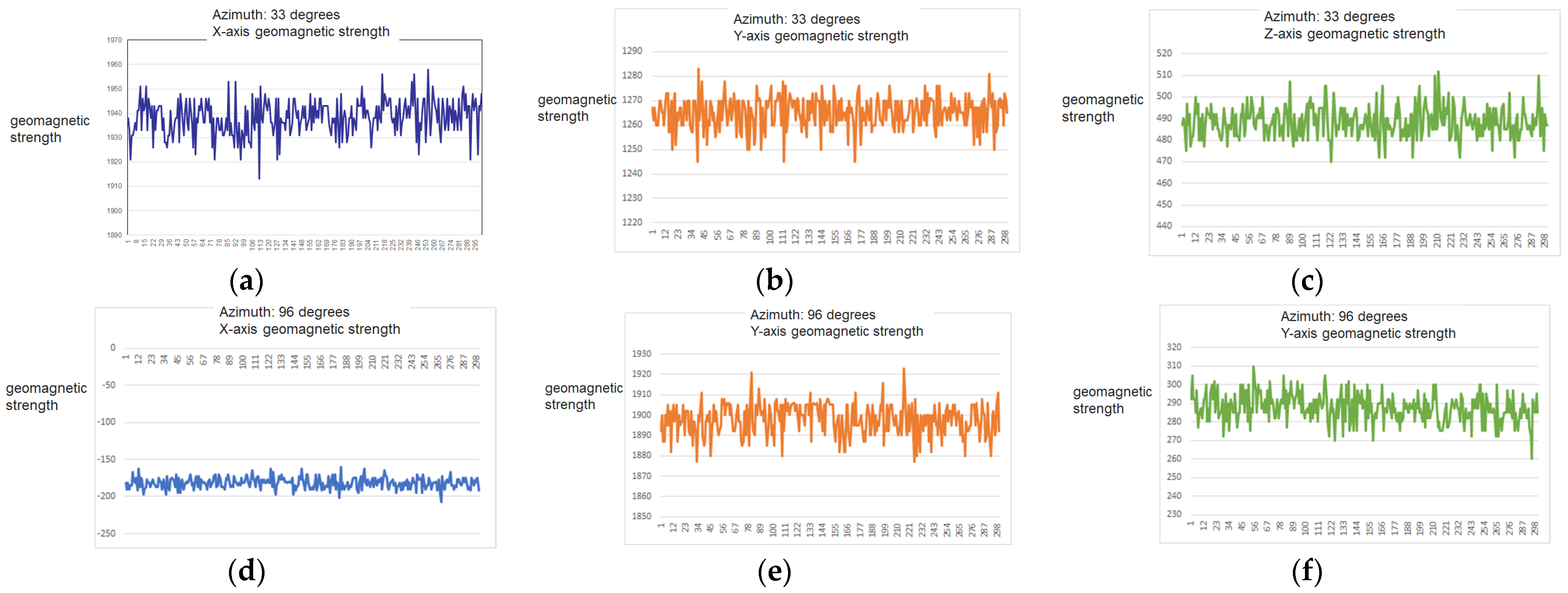
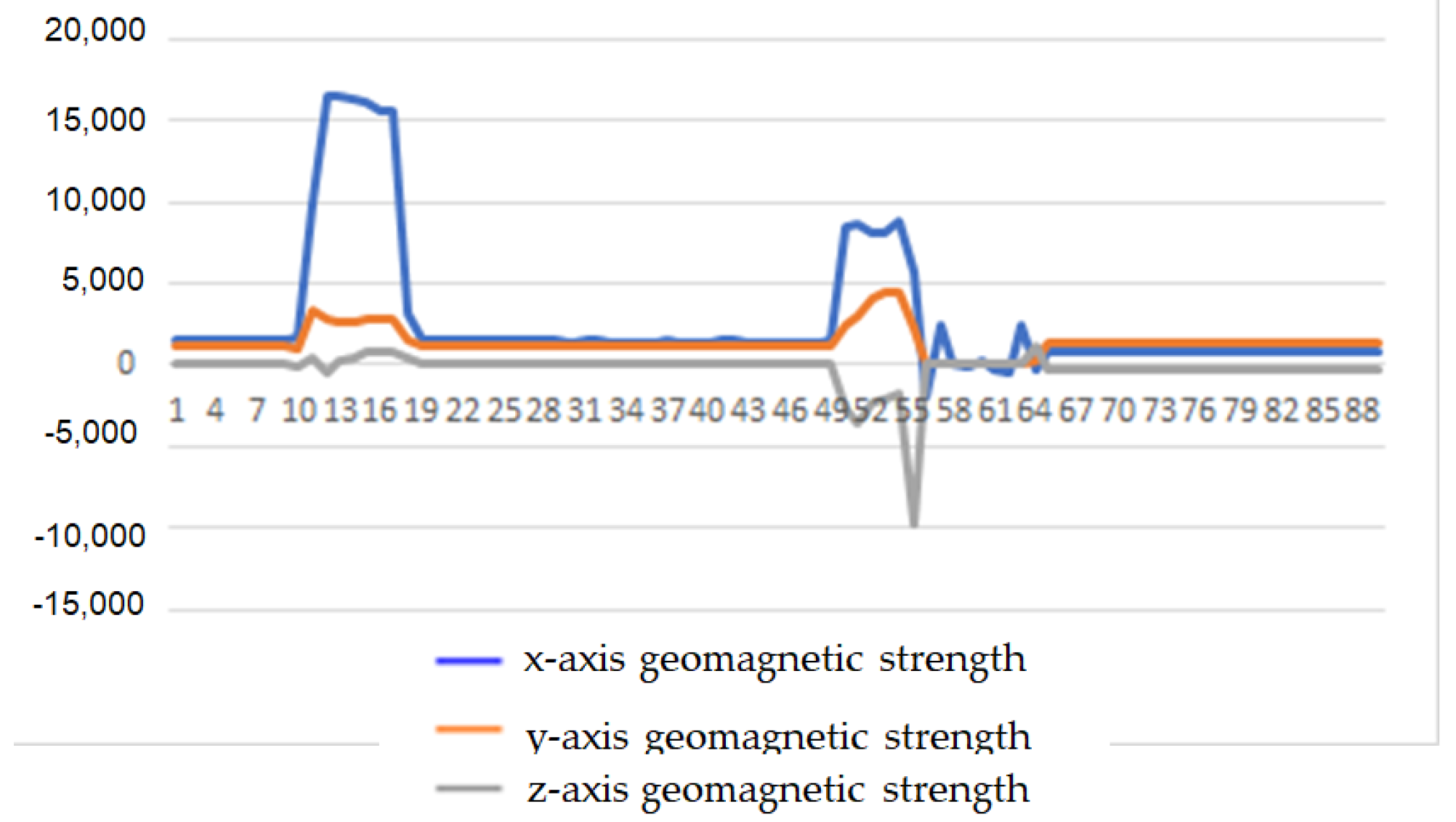



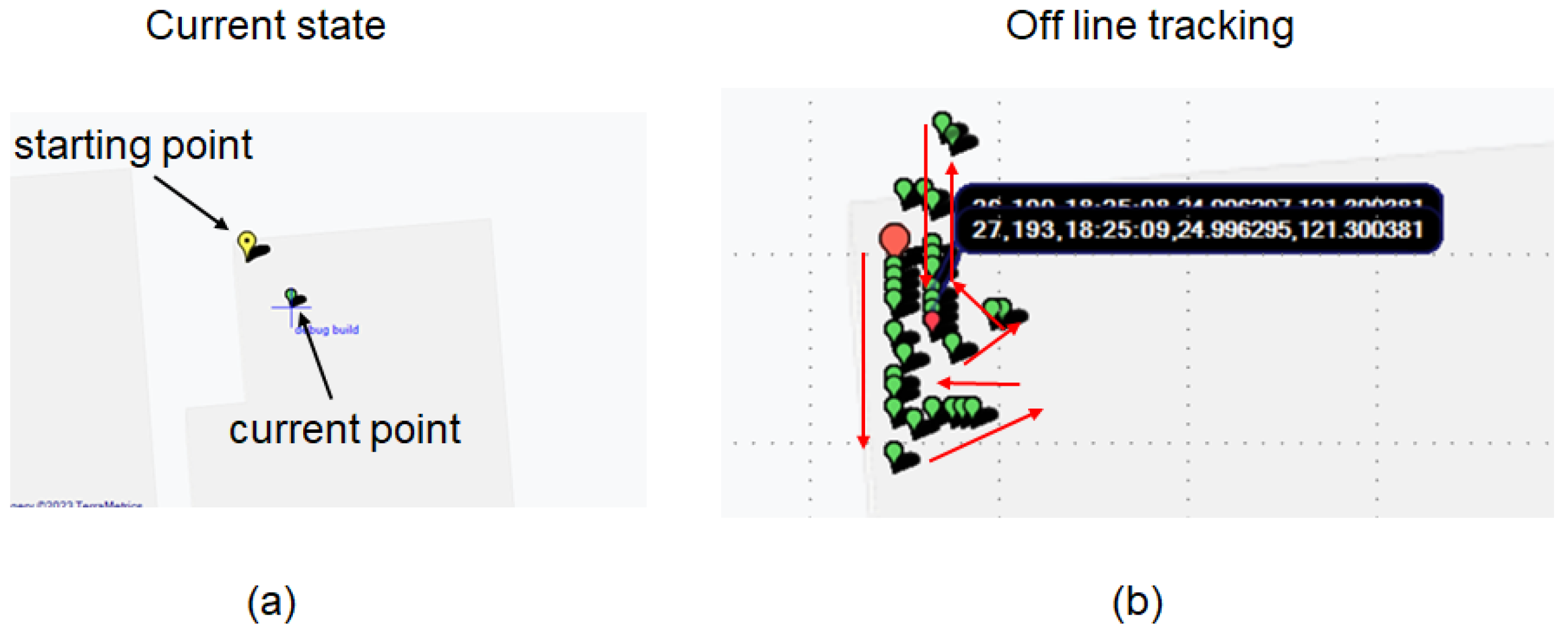



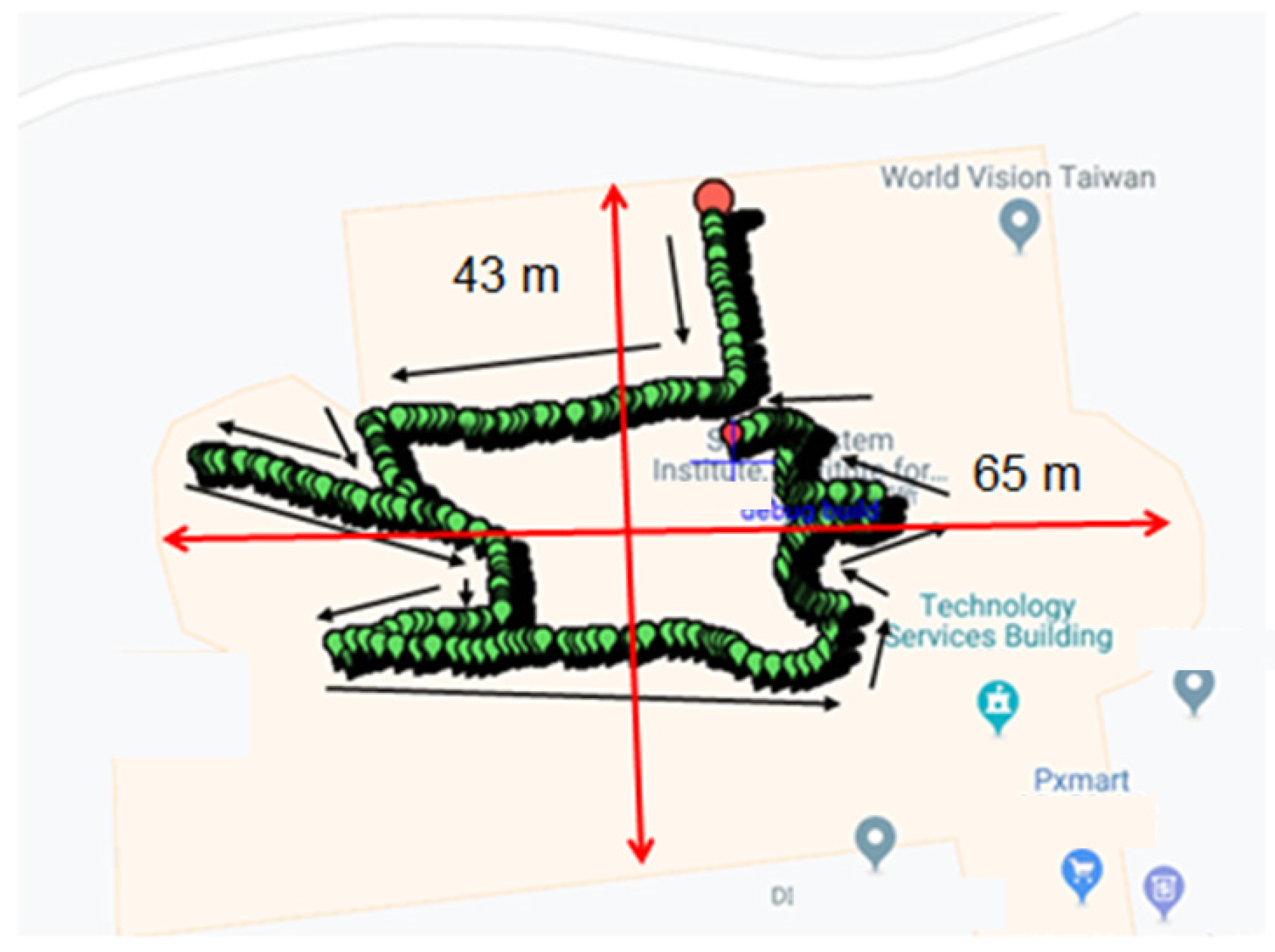
| No | x | y | z | Sqrt(x² + y² + z²) |
|---|---|---|---|---|
| 1 | 885 | −793 | 92 | 1191 |
| 2 | 907 | −773 | 92 | 1195 |
| 3 | 907 | −776 | 92 | 1197 |
| 4 | 905 | −778 | 105 | 1198 |
| 5 | 915 | −768 | 102 | 1198 |
| 6 | 910 | −773 | 112 | 1199 |
| 7 | 905 | −783 | 85 | 1199 |
| 8 | 912 | −776 | 87 | 1200 |
| 9 | 907 | −781 | 97 | 1200 |
| 10 | 905 | −783 | 105 | 1201 |
| 11 | 915 | −773 | 92 | 1201 |
| 12 | 920 | −768 | 90 | 1201 |
| 13 | 910 | −783 | 82 | 1203 |
| 14 | 917 | −773 | 110 | 1204 |
| 15 | 920 | −771 | 100 | 1204 |
| 16 | 907 | −786 | 105 | 1204 |
| 17 | 915 | −778 | 95 | 1204 |
| 18 | 912 | −781 | 102 | 1205 |
| 19 | 917 | −776 | 102 | 1205 |
| 20 | 922 | −773 | 107 | 1207 |
| 21 | 915 | −783 | 95 | 1208 |
| 22 | 910 | −791 | 92 | 1209 |
| 23 | 920 | −781 | 87 | 1209 |
| 24 | 920 | −781 | 90 | 1210 |
| 25 | 917 | −793 | 92 | 1215 |
| θ | x | y | z | ∆x | ∆y | ∆z |
|---|---|---|---|---|---|---|
| 288 | 747 | −2257 | −162 | 2 | −7 | 3 |
| 288 | 749 | −2264 | −159 | 5 | 2 | 5 |
| 288 | 754 | −2262 | −154 | −6 | −3 | −1 |
| 288 | 748 | −2265 | −155 | 0 | 1 | −3 |
| 288 | 748 | −2264 | −158 | 3 | 0 | 4 |
| 288 | 751 | −2264 | −154 | −1 | −2 | 7 |
| θ | x | y | z | ∆x | ∆y | ∆z |
|---|---|---|---|---|---|---|
| 346 | 1231 | −315 | −357 | 178 | −294 | 151 |
| 337 | 1409 | −609 | −206 | −673 | −924 | −35 |
| 296 | 736 | −1533 | −241 | −866 | 84 | −393 |
| 265 | −130 | −1449 | −634 | −284 | 262 | −111 |
| 251 | −414 | −1187 | −745 | −133 | 336 | −45 |
| 237 | −547 | −851 | −790 | 832 | −546 | 856 |
| 282 | 285 | −1397 | 66 | 834 | 1325 | −97 |
| Item | Super TaiRa | LoRa |
|---|---|---|
| Frequency Range | 410~990 MHz | EU 868,433 MHz US 915 MHz AS 430 MHz |
| Modulation | GFSK + CSS | GFSK + CSS |
| Data Rate | DSSS: 10 bps~10 Kbps GMSK: 1 Kbps~250 Kbps | 0.3 kbps to 50 kbps |
| Spreading factor | 6 dB~12 dB | 7 dB~12 dB |
| Tx Power output | Up to 20 dBm | Up to 14 dBm |
| Rx Sensitivity | −118~−136 dBm @ Channel BW = 125 KHz −115~−133 dBm @ Channel BW = 250 KHz −112~−130 dBm @ Channel BW = 500 KHz @ 1% PER | −123~−136 dBm@ Channel BW = 125 KHz −120~−133 dBm@ Channel BW = 250 KHz −116~−130 dBm @ Channel BW = 500 KHz |
| Transmission | Up to 100 km @LOS | Up to 20 km @LOS |
| System | Sensing Device | Additional Facilities | Pre-Built Fingerprinting Database | Construction/Maintenance Costs | Positioning Accuracy |
|---|---|---|---|---|---|
| DRP | Smartphone | No | Yes | High | 2.2 m |
| CSMS | Smartphone | No | Yes | High | 0.5 m |
| IGIPS | GY-273 geomagnetic sensor | No | No | Low | 0.8~1.5 m |
Disclaimer/Publisher’s Note: The statements, opinions and data contained in all publications are solely those of the individual author(s) and contributor(s) and not of MDPI and/or the editor(s). MDPI and/or the editor(s) disclaim responsibility for any injury to people or property resulting from any ideas, methods, instructions or products referred to in the content. |
© 2023 by the authors. Licensee MDPI, Basel, Switzerland. This article is an open access article distributed under the terms and conditions of the Creative Commons Attribution (CC BY) license (https://creativecommons.org/licenses/by/4.0/).
Share and Cite
Kuo, Y.-H.; Wu, E.H.-K. Intelligent Geomagnetic Indoor Positioning System. Electronics 2023, 12, 2227. https://doi.org/10.3390/electronics12102227
Kuo Y-H, Wu EH-K. Intelligent Geomagnetic Indoor Positioning System. Electronics. 2023; 12(10):2227. https://doi.org/10.3390/electronics12102227
Chicago/Turabian StyleKuo, Yen-Hui, and Eric Hsiao-Kuang Wu. 2023. "Intelligent Geomagnetic Indoor Positioning System" Electronics 12, no. 10: 2227. https://doi.org/10.3390/electronics12102227




